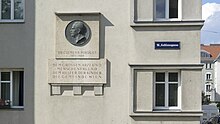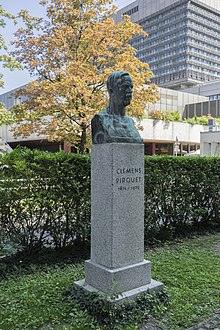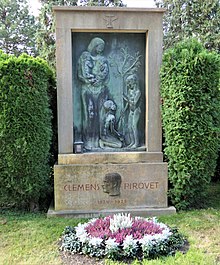Clemens von Pirquet

Clemens Peter Freiherr von Pirquet , actually: Clemens Peter Freiherr Pirquet von Cesenatico, called de Merdaga (born May 12, 1874 in Hirschstetten near Vienna , † February 28, 1929 in Vienna) was an Austrian pediatrician . He is known for his research in the fields of bacteriology and immunology .
Career
Clemens von Pirquet came from an old patrician family of the Principality of Liège ; Peter Pirquet, known as de Merdaga , was awarded the Military Order of Maria Theresa in 1809 and, in 1818, obtained the Austrian baron status for the family with the title of Cesenatico . Clemens von Pirquet's father, Peter Zeno von Pirquet, was a representative of the “landowner party” and played an important role as a member of the Reichsrat and Landtag in the Austrian parliament. The mother, Flora Freiin von Pereira-Arnstein, came from a Jewish banking family in Vienna. His brother is Guido von Pirquet , who is six years his junior and who also taught as a rocket technician at universities in the USA. Clemens completed his school education at the Schottengymnasium in Vienna, at the Kollegium Kalksburg and at the Vienna Theresianum , where he graduated in 1892. With the intention of Jesuits - Father to be, he first spent two years studying theology at the University of Innsbruck and from 1893 Philosophy in Leuven . He completed his studies with a master's degree, but changed his career aspirations and, much to the displeasure of his parents, began to study medicine in Vienna in 1895, which he continued in Königsberg and then in Graz , where he received his doctorate in 1900 .
After completing his studies, Clemens von Pirquet began his pediatric training with Otto Heubner (1843–1926) at the Charité in Berlin . In Berlin he also met his future wife, Maria Christine van Husen (* 1878), who came from Hanover. In 1901 he became a secondary doctor and in 1902 an assistant doctor at the St. Anna Children's Hospital in Vienna under Theodor Escherich (1857–1911). At the same time he worked under Rudolf Kraus (1868-1932) at the University Institute for Serotherapy. After his habilitation in 1908, he was so well known that he received a call to America, where he worked as a professor of paediatrics at the Johns Hopkins University in Baltimore for two years.
In 1910 he switched to the pediatric chair in Breslau . In 1911 he succeeded the late Theodor Escherich and took over the chair of paediatrics at the Vienna University Children's Clinic, where he worked until his death. At the end of the 1920s, Clemens von Pirquet was such a prominent and esteemed personality that he was nominated as a candidate for the presidency of the First Republic , which he himself took as deference rather than serious. It can be assumed that his private life was less happy because his wife was not accepted by his family, was mentally ill and dependent on barbiturates . At the height of his career, Clemens Freiherr von Pirquet committed suicide on February 28, 1929 at the age of 54, together with his (possibly terminally ill) wife in Vienna by taking cyanide .
His successor as head of the University Children's Hospital was Franz Hamburger (1874–1954).
Services
As early as 1903, Clemens von Pirquet deposited his work “On the theory of infectious diseases” at the Imperial and Royal Academy of Sciences . In 1905, together with his colleague Béla Schick (1877–1967), he first described serum sickness . In their classic monograph "The Serum Sickness" they also dealt intensively with the "time factor" (incubation time) that lies between the first injection of an antiserum and the occurrence of the serum sickness. In 1906 Clemens von Pirquet introduced the term “ allergy ” into medical terminology. During his investigations into the symptoms after the first and repeated injections of diphtheria serum, he was the first to recognize that antibodies can not only mediate protective immune responses , but can also be the cause of hypersensitivity reactions. In 1907, von Pirquet developed a method for the (early) diagnosis of tuberculosis , the tuberculin skin test , which was also known as the tuberculin test and the Pirquet reaction , at the children's clinic . For this achievement he was nominated five times for the Nobel Prize, which he did not receive. In 1911, Clemens von Pirquet took over the newly built University Children's Clinic in Vienna, where he founded a curative education department that same year, which was the first in the world to deal with clinical research and treatment of organic brain damage and behavioral disorders in children.
Due to his interest in questions of infant nutrition and his good contacts, he organized the feedings of the American children's aid organization (ARA - American Relief Administration) across Austria between 1919 and 1921 and became chairman of the League of Nations Committee for Infant Welfare. In the course of his occupation with nutrition, he developed his own nutritional system, the so-called NEM system (milk nutritional unit) .
In 1924, Pirquet developed the idea of numerically designating teeth in a tooth scheme using a two-digit system. This idea was in 1960 by Joachim Viohl taken, with whom he created a dental scheme since 1970 by the World Health Organization ( Engl. : World Health Organization , WHO) called WHO odontogram (ger .: WHO Tooth numbering system is) used internationally .
Posthumous appreciation
- Honorary grave of the City of Vienna in the Central Cemetery , Group 32 C, No. 9.
- On April 3, 1932 , a residential complex, the Pirquethof , built in 1929/1930 according to plans by Josef Hofbauer and Wilhelm Baumgarten , was opened in Gablenzgasse , Vienna- Ottakring . The portrait medallion of Pirquet on Gablenzgasse was created by Franz Seifert .
- In 1974 Pirquetgasse in Vienna- Donaustadt (22nd district), where the Pirquet family had owned Hirschstetten Castle since 1868, was named after the pediatrician.
- Dr.-Clemens-Pirquet-Strasse in Perchtoldsdorf is named after him.
- In 2010 the Austrian Mint minted a 50-euro gold coin as part of the Great Medicines of Austria series .
- In recognition of Pirquet's services, the following prizes are awarded:
- the Clemens von Pirquet Medal of the Austrian Society for Allergology and Immunology (ÖGAI) and
- the Clemens von Pirquet Prize of the Austrian Society for Child and Adolescent Medicine.
- In September 2016, the all-day primary school Pirquetschule was opened at Pirquetgasse 6b in the 22nd district of Vienna.
coat of arms
Peter Martin Pirquet von Cesenatico on the occasion of the elevation to the herbländisch-Austrian baron class, which took place with a diploma on April 14, 1818: “A shield half across and divided in length. In the upper right silver field three upright (2 over 1) red lions; In the red lower blue field, two crossed, golden, white-feathered arrows pointing upwards, the tips of which are set with a golden star. In the left silver half of the shield protrudes from the lower right blue edge of the field, a blue-clad arm, which with its bare hand holds a flying blue-white-red flag on a pole of the same color, at the tip of which a simple left-facing little golden eagle pointing to flight is attached to a golden button . The baron's crown rests on the shield, on which a crowned tournament helmet rises in its visor. From the crown grows an open blue eagle flight covered with a gold star, to which a red lion with an open jaw, a knocked out red tongue and a opened tail is set. The helmet covers are coated with silver on the right and blue with gold on the left ”. From: Constantin von Wurzbach : Biographisches Lexikon des Kaiserthums Österreich , Volume 22, pp. 340–342. - Pirquet of Cesenatico, the family .
Works (selection)
- -, Béla Schick: The serum sickness . Deuticke, Vienna 1905 ( online ).
- Allergy . In: Munich Medical Weekly . Volume 30.1906, ZDB -ID 200445-8 . Finsterlin, Munich 1906, pp. 1457-1458. (The first mention of the term "allergy").
-
Clinical studies on vaccination and vaccinal allergy. In: Munich medical weekly . 1906, p. 53.
- -. Leipzig 1907.
- The early response to protective pox vaccination . 1906
- Diagnosis of tuberculin by cutaneous vaccination . In: Berliner Klinische Wochenschrift . Volume 44.1907, ZDB -ID 200441-0 . Hirschwald, Berlin 1907, pp. 644-645.
- Theodor Heller , -: The status of the school doctor question in Austria. Negotiations of the “Austrian Society for Child Research” in Vienna under the chairmanship of Theodor Escherich in January 1908. Report by the Society's secretaries . 1908
- Diagnostic value of cutaneous tuberculin reaction at childhood tuberculosis . 1908
- Schematic representation of infant feeding . 1912
- Theodor Escherich, -: feeding the child during the war . 1915
- System of nutrition . 1917–1920 ( part 2 online )
- Ernst Mayerhofer (Hrsg.), - (Hrsg.), Josef Heussler ( Editing ): Textbook of folk nutrition after the Pirquet'schen system . 1920
- An Outline of the Pirquet System of Nutrition . (English). WB Saunders, Philadelphia 1922 ( online ).
- Pelidisi board . 1921
- Public health at war . Two volumes. 1926
- Ernst Mayerhofer (Hrsg.), - (Hrsg.): Lexicon of Nutrition . 1926
- Allergy of Age. The malignant tumors . 1930
- Handbook of Childhood Tuberculosis . 1930
literature
- H. Asperger : Pirquet von Cesenatico, Klemens Frh .. In: Austrian Biographical Lexicon 1815–1950 (ÖBL). Volume 8, Verlag der Österreichischen Akademie der Wissenschaften, Vienna 1983, ISBN 3-7001-0187-2 , p. 39 f. (Direct links on p. 39 , p. 40 ).
- Gabriele Dorffner: Clemens Freiherr von Pirquet. A gifted doctor and ingenious mind . Vier-Viertel-Verlag, Vienna 2004, ISBN 3-902141-10-7
- Elsbeth Hoff: The life and work of the Viennese clinician Clemens Freiherr von Pirquet . Nolte-Verlag, Düsseldorf 1938 (also dissertation Düsseldorf of November 20, 1937)
- Erna Lesky: Clemens von Pirquet . In: Wiener Klinische Wochenschrift . Volume 67, 1955, p. 638.
- Richard Wagner: Clemens von Pirquet. His life and work . Hopkins Press, Baltimore, Md. 1968
Web links
- Literature by and about Clemens von Pirquet in the catalog of the German National Library
- Clemens Pirquet in the Vienna History Wiki of the City of Vienna
- Entry on Clemens von Pirquet in the Austria Forum (in the AEIOU Austria Lexicon )
- Clemens Freiherr von Pirquet at the Austrian Society for Allergology and Immunology
- Clemens Pirquet. In: dasrotewien.at - Web dictionary of the Viennese social democracy. SPÖ Vienna (Ed.)
Individual evidence
- ↑ a b c Pirquet de Cesenatico, barons . In: Ernst Heinrich Kneschke : New general German nobility lexicon . Volume 7: Ossa - Ryssel . Voigt, Leipzig 1867, p. 158 f., Text online .
- ↑ Werner Köhler : Pirquet, Clemens Freiherr von. In: Werner E. Gerabek , Bernhard D. Haage, Gundolf Keil , Wolfgang Wegner (eds.): Enzyklopädie Medizingeschichte. De Gruyter, Berlin / New York 2005, ISBN 3-11-015714-4 , pp. 1164 f .; here: p. 1164.
- ↑ Professor Dr. Klemens Pirquet †. In: Wiener Bilder , No. 10/1929 (XXXIV. Volume), March 10, 1929, p. 7. (Online at ANNO ). .
- ↑ Lothar Kerp: Allergy and allergic reactions. In: Ludwig Heilmeyer (ed.): Textbook of internal medicine. Springer-Verlag, Berlin / Göttingen / Heidelberg 1955; 2nd edition ibid. 1961, pp. 1130–1159, here: p. 1131 ( founder of the allergy theory ).
- ^ Nomination Database - Physiology or Medicine. on nobelprize.org. 29th August 2012
- ^ A b Gregor Gatscher-Riedl: New Year 1919/20: Hunger Winter and American Children's Aid . In: Perchtoldsdorfer Rundschau . Edited by the market town of Perchtoldsdorf. Issue 02–03 / 2020. P. 9.
- ↑ Inventor of the dental scheme, Joachim Viohl on his 80th birthday Mitteilungsblatt Berliner Zahnärzte (MBZ) 6/2013, p. 38. Retrieved on October 29, 2014.
- ↑ Clemens von Pirquet, Numbering of Teeth, Wiener Klinische Wochenschrift, Volume 37, p. 566
-
↑ A memorial grave of the City of Vienna for Professor Pirquet .. In: Oesterreichische Kronen-Zeitung. Illustrirtes Tagblatt / Illustrierte Kronen-Zeitung / Wiener Kronen-Zeitung , March 2, 1929, p. 6 (online at ANNO ). (2nd column)
The mayor has ordered that the deceased Hofrat Professor Dr. Pirquet, in recognition of his great services to the Vienna Medical School and in particular his effectiveness in the field of child care after the war, an honorary grave of the city of Vienna in the central cemetery will be dedicated. - ↑ Daily news. (...) Opening of the Pirquethof. In: Arbeiter-Zeitung , No. 92/1932 (XLV. Year), April 2, 1932, p. 6 middle. (Online at ANNO ). .
- ↑ Pirquethof. In: dasrotewien.at - Web dictionary of the Viennese social democracy. SPÖ Vienna (ed.); Retrieved May 28, 2010
- ↑ A portrait medallion for the Pirquethof. In: Reichspost , 6 August 1930, p. 4 (online at ANNO ).
- ↑ dasrotewien.at. Accessed January 31, 2020 .
- ↑ Pirquetgasse - Vienna History Wiki. Accessed January 31, 2020 .
- ↑ 50 Euro gold Clemens Freiherr von Pirquet . In: numismatik-cafe.at , May 30, 2010, accessed on August 13, 2012.
- ↑ Pirquet School
| personal data | |
|---|---|
| SURNAME | Pirquet, Clemens von |
| ALTERNATIVE NAMES | Pirquet, Clemens Peter Freiherr von (full name) |
| BRIEF DESCRIPTION | Austrian pediatrician, bacteriologist, immunologist |
| DATE OF BIRTH | May 12, 1874 |
| PLACE OF BIRTH | Hirschstetten |
| DATE OF DEATH | February 28, 1929 |
| Place of death | Vienna |



